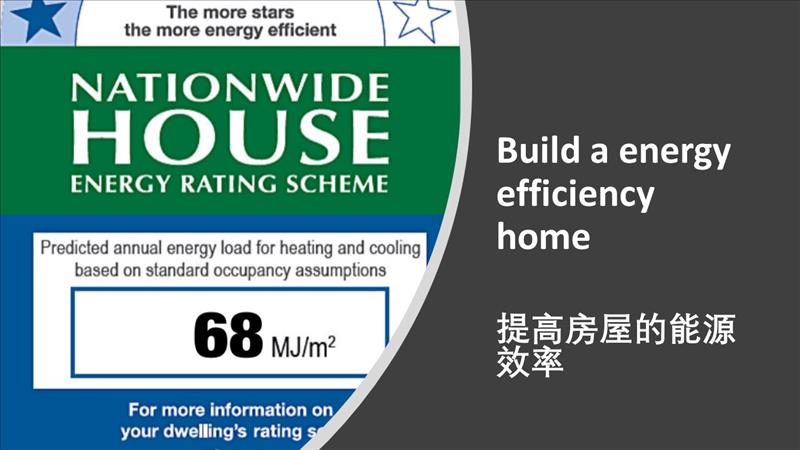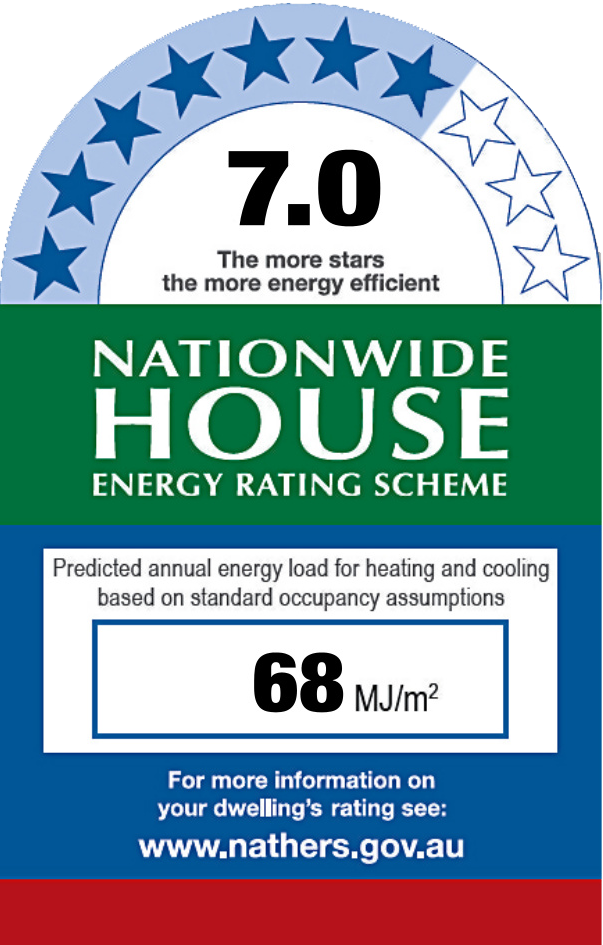
Today, Energy-efficient and environmentally friendly homes can be built with the proper techniques and methods in design and construction.
The minimum energy rating for most of Australia is six stars - set by the Nationwide House Energy Rating Scheme (NatHERS). This six-star minimum falls short of what is optimal in terms of environmental, economic and social outcomes. It’s also below the minimum set by many other countries. With current technology and knowledge, we should be building homes that meet higher standards than we currently do.
What is an energy rating
An energy rating indicates how much artificial heating and cooling is needed to keep the interior temperature within a comfortable range. The more stars a home has, the more energy-efficient it is and the less impact it will have on our environment. Homes with ten stars at the highest level of this rating do not require artificial heating or cooling all year round.

How energy ratings are measured
During the design phase of a building, an accredited NatHERS assessor will use several approved software programs to calculate the star rating of a new home. These tools use carefully calculate the amount of energy needed to heat and cool a home over a year and convert it to an energy rating. The assessment takes into account a large number of factors, with the more critical influencing elements including building location (climate zone); orientation; building materials; size, and type of glazing of windows; thickness of insulation (roof, walls, floors); ventilation; lighting; flooring coverings (carpet, flooring), etc.
Smarter design choices during the design stage can reduce the amount of energy needed to maintain a comfortable temperature with little to no additional building cost.
What does a higher rating mean?
The homeowner means that the house is naturally comfortable for a more extended period throughout the year. The ideal temperature for most people is about 21°C. An energy-inefficient home loses temperature and leaks cool air, leaving the house in constant need of heating and cooling. This unnecessary heating and cooling consumes about 40% of the home's energy and could be avoided.
Building a home with a higher energy rating means you can maintain ideal and comfortable temperatures all year round. A house that uses less energy to maintain a comfortable temperature reduces bill costs.
What does a new home builder need to do?
Before issuing a building permit, new home builders need to hire a qualified assessor to evaluate the design for energy ratings. If six stars are not initially achieved, the assessor will recommend changes to the design or house specifications.
Renovations or extensions that affect more than 50% of the volume of the existing house will also require the entire building to achieve six stars.
With the development of technology and experience, building an energy-efficient home is no longer difficult to achieve. However, it requires a builder to have an understanding and the desire to produce such an outcome. These houses require a little more thought and effort to construct.
We can improve energy efficiency in 6 ways.
1. Improve the use of sunlight
We know that the amount of sunlight a house receives is related to the angle the sun hits the earth and the time of day it shines. In Melbourne, the winter solstice is the day of the year with the least amount of sunlight (about 9 hours) and the sun's maximum altitude angle at midday is about 29°. The summer solstice is the longest day of the year (approximately 14.5 hours), and the maximum altitude angle of the sun at noon is about 75°. A building designer using computer-aided design software can calculate the effect of eaves, surrounding buildings and vegetation on the shading of a house at different times of the year, thus ensuring that the house has proper sunlight in the winter and proper shading in the summer. A good design makes the best use of windows to get more sunlight to heat the house in winter and less sunlight in summer.
2. Improve the orientation of the house
Since Melbourne is in the southern hemisphere, the sun rises in the east and sets in the west in a northerly direction. When choosing a house design, make sure that the most utilized areas are on the north side of the house. Take advantage of the winter sun to keep these rooms warm and bright. Minimize west-facing windows and ensure they are well shaded in the summer; try to avoid south-facing windows, which get little to no winter sun. Consider sharing walls with neighbours, particularly on the east or west boundaries.
Sharing walls reduces the wall area exposed to outside temperature fluctuations and, therefore, significantly reduces the heat loss/gain to the house.
3. Optimize window design
40% of the household's energy is lost through windows. This loss can be reduced by 80% with better design. The three main principles of energy-smart window design are listed below.
Maximise winter heat gain by orientating windows to the north and
sizing windows to suit the amount of thermal mass in the dwelling.
Minimise winter heat loss through appropriate window sizing,
together with double glazing and/or close-fitting internal coverings
such as drapes with pelmets.
Minimise summer heat gain by protecting windows with external
shading devices, sizing and positioning of windows.
4. Add insulation materials
Insulation creates an important barrier between the exterior and interior of your house. It keeps the heat out in the summer, while in the winter, it keeps the heat in. Insulating your home's ceilings, walls, and floors can save you up to 45%-55% of the running costs of your home. So add as much insulation as you can while making sure it is installed correctly and without gaps.
5. Take advantage of the thermal mass of building materials
Thermal mass is the ability of a material to absorb and store heat energy. Dense materials have a higher thermal mass. A material with thermal mass absorbs heat from the air in a room or from sunlight exposure. This heat is slowly released into the room for hours. Changing the building materials of a house from light (timber floors and timber walls) to heavy (concrete foundations and brick interior walls) can reduce heating and cooling expenses by 30% and 50%.
6. Seal the house
Uncontrolled air leakage can significantly reduce the energy efficiency of a house. Reducing uncontrolled air leakage can prevent heat loss in winter and prevent the entry of warm air in summer. This can save up to 20% on heating and cooling costs and improve comfort. Air can leak through door and window frames, exhaust fan openings, air conditioning vents, chimneys, joints in different building materials, dryer vents, and other places. By sealing these holes, the house's energy efficiency will greatly improve the energy efficiency of the house.
Concentric Integrity New Homes is committed to building energy-efficient homes that reduce home energy use, thereby increasing the comfort of your home and minimizing the bills you pay to maintain that comfort.
If you are building a new home, consider building energy efficiency early or contact me for a consultation.
如今,节能环保型的房屋不再是那些独特的,私人定制式房屋的专利。只要在设计和建造中使用正确的技术和方法,就能建造出节能环保的房屋。
澳洲大部分地区的最低能源评级是六星级--由全国房屋能源评级计划(NatHERS)制定。从环境、经济和社会结果来看,这个六星级的最低标准并不高。也低于许多其他国家设定的最低标准。笔者认为,以目前的技术和知识,我们建造的房屋应该达到比目前更高的标准。
什么是能源等级
能源等级表示需要多少人工加热和冷却来保持住宅内部温度在一个舒适的范围内。星越多,房子就越节能,对我们的环境造成的影响就越小。在这个评级的最高级十颗星的房子全年都不需要人工加热或冷却。
如何评定能源等级
在建筑的设计阶段,合格的NatHERS评估员将使用几种被批准的软件来计算新住宅的星级。这些工具使用精心设计的算法,计算出一年内房屋供暖和制冷所需的能量,并将其转换为能源等级。评估会考虑非常多的因素,比较重要的影响要素包括建筑位置(气候区域);朝向;建筑材料;窗户的尺寸,位置,玻璃类型;隔热材料的厚度(屋顶,墙壁,地板);通风;照明;地面材料(地毯,地板)等。
在设计阶段,更明智的设计选择可以减少维持舒适温度所需的能源,几乎没有额外的建筑成本。
较高的评级意味着什么?
对于房主来说,这意味着房子在一年中的更长时间里都是自然舒适的。大多数人感到舒适的理想温度是21°C左右,这大约是我们在夏天开了空调和冬天开了暖气的温度。节能效率低下的房子会流失温度并泄露冷气,使得房屋不断产生供暖和制冷的需求,这种不必要的供暖和制冷大约消耗了40%的家庭能源,本来可以避免。
建造能源等级更高的房屋,意味着你一年四季都能保持理想和舒适的温度。用更少的能源来维持舒适的温度的房子,减少账单费用。
新房建筑商需要做什么?
在颁发建筑许可证之前,新房建筑商需要聘请有资质的评估师对设计进行能源评级评估。如果最初没有达到6颗星,评估员会提供对设计或房屋规格的修改建议。
如果进行装修或扩建,并影响到现有房屋50%以上体积的改建或扩建,也需要将整个建筑提升到6星级。
随着技术的发展经验的累积,建造一个节能房屋已经不难实现。然而,这些房屋的建造需要更多的思考和努力,需要建筑商和业主都有这个意愿来实现这样的结果。
大多数建筑公司只追求快速的批量建造相同的房屋,而不考虑长期效益,而在协诚新家,我们热衷于创造节能房屋,这些房屋不仅看起来漂亮,而且年复一年的提供高效的节能表现。
在我们的今后的文章中,我们将讨论节能房屋是如何运作的,以及需要什么来最大限度地实现节能目标。也欢迎大家和我联系讨论。
我们可以从下面六个方面提高能源效率:1. 提高对太阳光的利用
我们知道,房屋接受太阳光的多少是与太阳照射地球的角度和光照时间有关。在墨尔本,冬至是一年中日照时间最少的一天 (约9小时),太阳在正午时的最大高度角约为29°。夏至是一年中日照时间最长的一天(约14.5小时),太阳在正午时的最大高度角约为75°。建筑设计师通过计算机辅助设计软件进行遮阳研究,可以计算出屋檐、周围的建筑物和植被在一年中的不同时期对房屋遮阳的影响 ,从而确保房屋在冬季有适当的阳光,夏季有适当的阴影。好的设计可以使窗户得到最佳的利用,在冬季得到更多阳光加热,在夏季减少阳光照射。
2. 改善房屋朝向
由于墨尔本在南半球,太阳在偏北的方向���升西落。所以选择户型设计时,要确保利用率最高的区域在房子的北面。利用冬季的阳光使这些房间保持温暖和明亮。尽量减少朝西的窗户并确保它们在夏季有良好的遮阳;尽量避免朝南的窗户,因为这些窗户几乎没有冬季阳光。可以考虑与邻居共用墙壁,共用墙体可以减少暴露在外界温度波动中的墙体面积,因此显著减少房屋的热量损失。
3. 优化窗户设计
40%的冷却或加热的能量是从窗户流失的。如果优化设计,这个损失可以减少80%。优化的窗户设计主要有:
(1)将窗户朝向北方,并根据住宅中的热质量确定窗户的大小,从而最大限度地增加冬季的热量。
(2)使用适当的窗户尺寸,双层玻璃窗,最大限度地减少冬季热量损失。
(3)使用外部遮阳设备以及窗帘,最大限度地减少夏季的热量摄入。
4. 增加隔热材料
隔热材料在你的房子的外部和内部之间建立了一个重要的屏障。在夏天,它把热量挡在外面,而在冬天,它把热量留在里面。对房屋的天花板、墙壁和地板进行保温,可以为你节省高达45%-55%的房屋运行成本。因此,增加尽可能多的隔热材料,同时确保正确安装,没有缝隙。
5. 利用建材的热质量
热质量是一种建材储存热量的能力。致密的材料具有更高的热质量。具有热质量的材料从房间的空气中吸收热量或阳光照射的热量。这些热量会在几个小时内慢慢释放到房间里。将房屋的建筑材料从轻质的(木地板和木墙)改为重质材料(混凝地基和砖头内墙),可以减少30%的供暖和50%的制冷支出。
6. 密封房屋
减少空气泄漏可以防止冬季的热量损失,并防止夏季的暖空气进入。这可以节省高达20%的加热和冷却成本并提高舒适度。门框窗框,排风扇口,空调口,烟囱,不同建材的接缝,烘干机通风口等地方都可能泄露空气。密封这些漏洞以后,房子的气密性会大大改善。
协诚新家致力于建造高能源效率的房屋,减少家庭能源使用量,从而增加你住房的舒适度和最大限度地减少你为保持这个舒适度所支付的帐单。
如果你正好要建新房,要尽早考虑建筑节能的问题,或者和我联系咨询。



